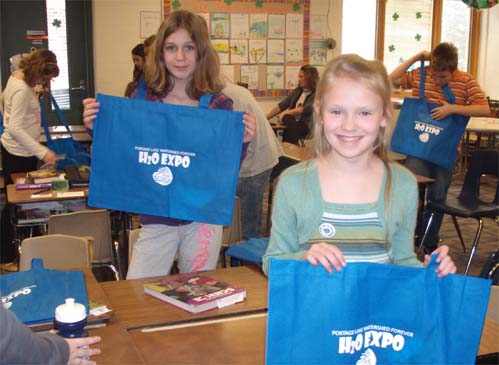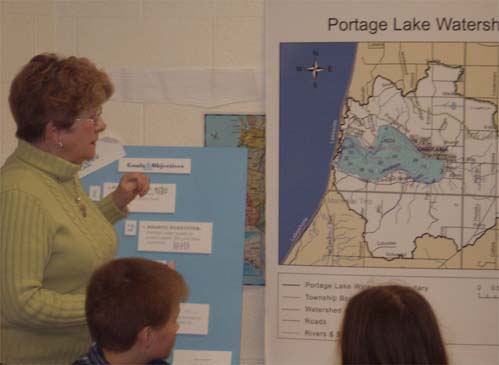|
Fifth Graders
want to do
their part to save the
Portage Lake Watershed
On
March 1, 2012 we had a special visitor. Her name was Mrs. Reed. She was
very nice person. She told us about Portage Lake Watershed Forever. The
Watershed is where people take care of land and water. Mrs. Reed told us
about the invasive species. She told us about Phragmites and Eurasian
Watermilfoil. She told us that Mike Acton started the watershed. We
learned to dump your tank of water before you go lake to lake. The
watershed is 25 square miles big. We got stuff for us to keep. Mrs. Reed
was a very nice person. She told us about seawalls. She said seawalls
should be natural. She said invasive species get here by freighters. A
watershed is land, water, streams, and rivers. When Mrs. Reed was done
she left.
~by Rylan C.

Our
class had a speaker from the Portage Lake Watershed named Mrs. Reed come
in. It was on Thursday the first of March. It was our science class when
she came in. She came in with at least five posters of the town's
watershed. She said a watershed was a body of water with streams and
underground water lead to. Mrs. Reed informed us of the invasive species
that were in the lake. Some like the phragmites, zebra mussels, and the
Eurasion watermilfoil. They came off freighters from different countrys
by sticking to boats. She said that one way the people are trying to
prevent them is by washing your boats before going into fresh water.
Since some of those invasive species already came into the great lakes
we are trying to get them out by chemicals. I remember when I used to
live on the lake and that the county would come over and spray our
beach. Another problem was the unnatural seawalls. The water would
bounce back and forth so there was no habitat there. She said it would
be better with a natural seawall. She said that she had her own
unnatural seawall and that she wished she didn't.
~from Katie B.
Portage Lake
Watershed Forever!
A
person from the Portage Lake Watershed Forever named Mrs. Reed came to
talk to us. It was about preserving Portage Lake. She talked about
Eurasian water milfoil, phragmites, zebra mussels, and seawalls and
native plants. The only way to get rid of phragmites is to burn them or
spray them with a chemical. You use a chemical to kill Eurasian water
milfoil. She told us not to put up steel seawalls, but plant native
plants instead. She didn't talk too much about zebra mussels. The
watershed is 25 square miles. Everything that soaks into the ground goes
into the watershed. You should rinse off your boat, so you don't spread
invasive species. I will try very hard to preserve and protect the
Portage Lake Watershed.
~Benjamin J.
 |

Mrs. Reed came to
Onekama School to talk about the Portage Lake Watershed. One of the
things she talked about is Eurasian Watermilfoil. Eurasian Watermilfoil
is some kind of seaweed that grows and sort of takes over the native
plants. She also talked about Phragmites. Phragmites are reeds that
lives on shorelines and sort of over power the good native plants. It
grows long roots over the native plants and kill the good plants. She
also talked about seawalls. You want to have natural seawalls instead of
metal seawalls because the metal seawalls don't give the fish a good
habitat because the water will just come up and and splash up against it
and come back and keep on doing it. A watershed is a big body of water
under ground then comes into streams and goes into the lakes.
~by Ben A.

Gifts from the
Watershed Committee
On
Friday someone special came in to talk about our Portage Lake Watershed.
Her name was Mrs. Reed and she talked about Invasive species such as the
Zebra Mussels. We learned all about invasive and native species. Native
is a species that belong in our lakes. Invasive are the exact opposite,
they harm our lakes and should not be there. She showed us maps and at
the end we got a big blue bag, a water bottle, a sticker, a paper with
the water pledge on it(Which we did shortly after receiving it) a look
out paper for a plant, (I forget witch one) and a pin that said, "I did the water pledge." I use my bag to carry
books and extra things. We learned about sea walls too and how they can
be bad sometimes and what they did. Mrs. Reed is a real help for the
watershed.
~by McKenna I.

Mrs. Reed came to visit our classroom and talk about
the Portage Lake Watershed. She talked about seawalls, how you shouldn't
build metal steel walls, just plant native plants for a seawall. We also
got free stuff, like a beach bag, a water bottle and all kinds of other
things. She told us about different types of invasive species like
Eurasian Watermilfoil and Phragmites. Mrs. Reed also said to rinse off
your boat if you are done driving it and are going to switch it to
another lake. I learned a lot from Mrs. Reed.
~from Jarrett B. |